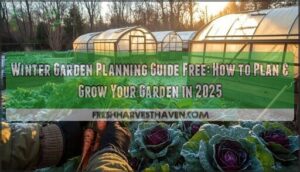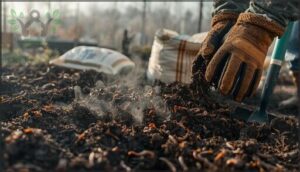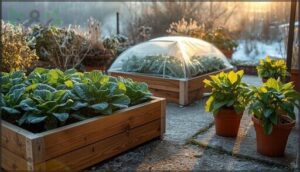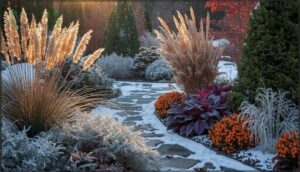This site is supported by our readers. We may earn a commission, at no cost to you, if you purchase through links.

Most gardeners hang up their tools when the first frost hits, but that’s precisely when your winter garden should be coming to life. With the right planning, you can harvest fresh kale, carrots, and herbs well into January—even in climates where snow blankets the ground.
The secret isn’t expensive equipment or a greenhouse; it’s understanding which crops thrive in cold weather and how to protect them with simple, affordable techniques.
This winter garden planning guide, free of complicated jargon, will walk you through timing your plantings, choosing cold-hardy varieties, and creating microclimates that extend your growing season by months. You’ll discover that winter gardening isn’t just possible—it’s often easier than battling summer heat and pests.
Table Of Contents
- Key Takeaways
- Essential Winter Garden Planning Steps
- Choosing The Right Winter Crops
- Preparing Your Soil for Winter Planting
- Mapping and Designing Your Winter Garden
- Frost Protection and Season Extension Methods
- Maintaining and Caring for Your Winter Garden
- Creating Visual Interest in Winter Gardens
- Supporting Wildlife in Your Winter Garden
- Harvesting and Enjoying Winter Crops
- Environmental and Personal Benefits of Winter Gardening
- Frequently Asked Questions (FAQs)
- What month do you start a winter garden?
- How to create a winter garden?
- What do you plant in your garden in the winter time?
- What to do to get a garden ready for winter?
- Should you plan a Winter Garden?
- How do you plan a garden for winter?
- Should winter garden planning include grouped planting?
- Are Winter Garden ideas a good idea?
- How can I make the most of winter in the garden?
- What can you do with gardening through the winter?
- Conclusion
Key Takeaways
- Winter gardening succeeds when you plant cold-hardy crops like kale, carrots, and brassicas 6-8 weeks before your first frost, using your USDA hardiness zone and local microclimates to guide timing rather than expensive equipment.
- Simple frost protection methods—cold frames, row covers, and poly tunnels—can extend your growing season by 2-4 weeks and create microclimates up to 1.5 zones warmer, letting you harvest fresh vegetables well into January.
- Your winter garden’s productivity hinges on soil preparation with compost and organic amendments, strategic layout using south-facing locations and raised beds, and consistent maintenance including proper watering, mulching, and pest monitoring.
- Beyond fresh produce, winter gardening delivers environmental benefits like reduced soil erosion (up to 86% with compost), water conservation (70% less evaporation with mulch), and mental health improvements by keeping you engaged with nature year-round.
Essential Winter Garden Planning Steps
Getting your winter garden off to a strong start takes a little planning and know-how. There are a few key steps you’ll want to think about before you get your hands dirty.
Let’s walk through the essentials to set your garden up for success.
Timing Plantings Before The First Freeze
Before you even dig in, timing your planting around local freeze date variations is your secret weapon. Use regional data resources to pinpoint the planting weeks—usually 6 to 8 weeks before your first frost.
To guarantee proper planning, consider that average first frost dates vary by state. Frost type effects matter: light frosts favor cold-hardy crops, while severe freezes demand extra frost protection.
Smart garden planning means better crop survival and thriving winter crops.
Assessing Your Garden’s Microclimates
Once you’ve got your planting dates sorted, it’s time for Microclimate Analysis. Your winter garden’s success hinges on spotting warm nooks, mapping Wind Patterns, and avoiding Frost Pockets. Notice how Solar Radiation warms south-facing walls, while dips collect cold air.
Check Soil Temperature and drainage—these small details shape your garden planning, soil preparation, and winter garden design more than you’d think. Understanding microclimate effects is vital for creating a thriving winter garden.
Using The USDA Hardiness Zone Map
After sizing up your microclimates, it’s time to let the USDA Plant Hardiness Zone Map guide your winter garden planning. Plug in your ZIP code to pinpoint your zone classification and temperature ranges.
This map helps you match cold-hardy crops to local frost dates, while factoring in climate variability. Remember, microclimate analysis adds nuance beyond broad USDA hardiness zones.
Choosing The Right Winter Crops
Picking the right crops is the secret to a thriving winter garden. Some vegetables and herbs handle cold far better than others.
Here’s what you’ll want to keep in mind as you plan your winter lineup.
Best Leafy Greens for Cold Weather
Did you know leafy greens like Winter Kale and collards become sweeter after a frost? These cold hardy varieties thrive where others wilt, making them stars of winter gardening.
Winter kale and collards sweeten after frost, thriving where other vegetables fail in cold weather gardens
Arugula and bok choy join the lineup of frost tolerant plants, delivering hearty leafy green nutrition. With proper frost protection, these cold-hardy crops promise a vibrant winter harvest—even after freezing temperature effects.
Top Root Vegetables for Winter
Root Crop Selection is where winter gardening shines. Carrots, parsnips, and leeks offer impressive Cold Hardiness—roots stay snug underground, ready for Winter Harvesting. Frost Tolerance means sweeter flavors and longer shelf life in Root Cellaring. If you crave a winter garden that delivers, choose root vegetables that thrive in cold, and you’ll savor every bite.
- Sweet, frost-kissed carrots
- Hearty, resilient parsnips
- Flavorful, cold-hardy leeks
Selecting Brassicas and Herbs
Brassicas are winter’s workhorses—think kale, cabbage, and broccoli bred for cold. Herbs like parsley and winter savory add flavor and resilience. Success hinges on smart planting data and timing: space brassicas well, sow herbs early. Cold-hardy crops offer substantial nutritional aspects, especially post-frost.
Here’s a quick reference for Winter Garden Planning:
| Brassicas | Winter Herb Varieties |
|---|---|
| Kale (Winterbor) | Parsley |
| Cabbage (January King) | Cilantro |
| Broccoli (Purple Sprouting) | Winter Savory |
| Cauliflower (Snow Crown) | Peppermint |
Preparing Your Soil for Winter Planting
Getting your soil ready is the secret sauce for strong winter crops. A few smart steps now can set the stage for healthy growth, even when the weather turns. Here’s what you’ll want to focus on next.
Amending Soil for Winter Crops
Ever wondered why winter gardening thrives in well-prepped soil? Start with Soil Testing to guide your pH Adjustment and nutrient needs. Boost Organic Matter—think compost or cover crops—to fuel Microbial Balance and Nutent Cycling.
Smart soil preparation means better root resilience and steadier temperatures, giving cold-hardy crops a fighting chance. Careful garden planning sets the stage for vigorous soil care and maintenance.
Composting and Fertilizer Selection
Think of compost as your garden’s winter fuel—layer 1-2 inches of compost materials over beds to enrich nutrient cycling and insulate roots.
For soil preparation, pair organic soil amendments with slow-release fertilizer types that won’t burn tender plants.
Winter mulching with compost tea or liquid kelp fertilizer boosts microbial life, while strategic fertilizer selection ensures steady nourishment when spring arrives.
Mapping and Designing Your Winter Garden
Once you’ve prepped your soil, it’s time to think about where everything will actually go. A well-designed winter garden layout maximizes sunlight, protects plants from harsh winds, and optimizes your available space.
Let’s walk through three key strategies that’ll help you create a garden that’s both productive and easy to manage through the colder months.
Smart Spatial Planning and Garden Layout
Planning your winter garden layout is like solving a puzzle—every piece matters. Smart garden mapping helps you squeeze more productivity from every square foot while respecting each plant’s needs.
Here’s how to enhance your spatial design:
- Draw a grid layout to visualize bed arrangement and improve space utilization by up to 35%
- Group crops by water and nutrient requirements to boost resource efficiency by approximately 25%
- Use raised beds to increase planting density by 30% compared to traditional gardens
- Stagger plantings in equidistant patterns to potentially raise yields by 20%
Thoughtful layout strategies transform cramped spaces into thriving winter havens.
Consider your garden’s unique microclimates during this planning phase—temperature variances can shift dramatically within just a few feet, affecting everything from germination to harvest timing.
Selecting South-Facing and Sheltered Locations
Your garden’s positioning acts like nature’s thermostat—south-facing locations increase solar heat gain while sheltered spots shield plants from harsh winds. Effective windbreak structures protect crops up to 30 times their height, creating microclimate zones several degrees warmer than exposed areas.
Avoid frost pockets in low-lying spots and map your garden’s microclimates carefully to overcome location-specific challenges in winter gardening.
Incorporating Containers and Raised Beds
Raised beds and containers turn winter garden planning into a flexible art. These setups warm up faster than ground soil, improve drainage benefits, and give you precise control over bed soil preparation.
Container crop choices like leafy greens thrive because you can relocate them to catch shifting sunlight. Raised beds boost winter yield impacts by 10-20%, while proper protection management techniques—like mulching and frost covers—keep your crops healthy through freezing temperatures.
Frost Protection and Season Extension Methods
Once your garden layout is set, the next step is protecting your plants from frost and cold snaps. A few simple structures can keep your crops thriving even when temperatures drop.
Let’s look at the most effective options for extending your growing season without spending a fortune.
Using Cold Frames and Row Covers
When temperatures start dipping, cold frames and row covers become your winter garden’s best allies. Cold frames extend your growing season by 2 to 4 weeks, creating microclimates about 1.5 hardiness zones warmer while offering pest exclusion.
Row covers provide 2°F to 10°F of temperature moderation and frost protection. Proper frame ventilation and cover installation are essential—you’ll boost crop yields and protect your cold-hardy crops beautifully.
Benefits of Poly Tunnels and Frost Cloth
Beyond cold frames and row covers, poly tunnels and frost cloth bring powerful temperature regulation and microclimate creation to your winter gardening toolkit. Poly tunnels can extend your season by nearly a month on both ends, while frost cloth weights from 0.45 to 2.0 oz offer flexible frost prevention for your cold-hardy crops.
Here’s what they deliver:
- Season extension that lets you start planting earlier in autumn and harvest deeper into winter
- Crop protection against damaging winds, heavy snow, and those sneaky freeze-thaw cycles that harm plant tissues
- Winter harvest success with leafy greens and brassicas thriving in protected microclimates where they’d struggle outdoors
Ventilation Tips to Prevent Overheating
While poly tunnels and frost cloth trap warmth beautifully, you’ll need smart thermal management to avoid cooking your plants on sunny winter days. Open vents for short bursts—two or three times daily—rather than one long session to maintain climate control without losing precious heat.
Add circulation fans in an oval pattern to prevent hot spots, and pair heating solutions with ventilation systems so cold drafts don’t shock your winter garden crops.
Maintaining and Caring for Your Winter Garden
Your winter garden won’t thrive on autopilot—it needs consistent attention to stay productive through the cold months. Think of maintenance as your insurance policy against frost damage, disease, and disappointing harvests.
Let’s walk through the essential care tasks that’ll keep your plants healthy and your garden producing all winter long.
Trimming, Tidying, and Mulching
Think of winter maintenance as giving your garden a protective blanket and a haircut. Late winter pruning removes dead or diseased wood, improving airflow and promoting strong spring growth. Here’s what to focus on:
- Trim dormant plants in January or February to minimize stress
- Apply 2-3 inches of organic mulch to regulate soil temperature and prevent frost heaving
- Practice garden sanitation by removing diseased debris
- Use proper deadheading methods on spent blooms for tidier beds
Mulch protects roots from freeze-thaw cycles while enriching soil as it decomposes.
Winter Watering Strategies
Even dormant plants need hydration, especially during extended dry spells. Water your winter garden when soil isn’t frozen and temperatures climb above freezing—midday works best. Apply water slowly at the base to guarantee deep soil moisture penetration without wetting foliage, which risks ice damage.
Evergreens demand more attention than deciduous plants. Proper winter irrigation and frost management protect roots from desiccation, supporting healthier spring growth and maintaining essential soil care throughout the season.
Monitoring and Managing Pests
Monitoring your winter garden regularly helps you spot pests before they multiply. Many insects overwinter in soil and debris, so inspect plant undersides and leaf litter weekly.
IPM strategies combining removal of infested material with organic controls like neem oil work best.
Climate impact matters—mild winters increase pest survival rates. Track what you find; those notes guide smarter pest management and plant protection all season.
Creating Visual Interest in Winter Gardens
Winter doesn’t mean your garden has to fade into the background. You can create a landscape that’s just as beautiful and vibrant as your summer beds with the right design choices.
Let’s explore three key strategies that’ll keep your winter garden looking vibrant and intentional all season long.
Focal Points With Evergreens
Evergreens work like anchors in your winter garden design, holding everything together when other plants fade away. These evergreen specimens provide year-round structure while offering visual contrast against snow and creating essential wildlife shelter for birds seeking refuge.
Here are three design strategies to heighten impact:
- Layer by height – Combine tall conifers with medium shrubs and low groundcovers for depth
- Frame pathways – Plant columnar junipers or boxwood along walkways to guide the eye
- Create focal points – Position a striking Colorado Blue Spruce as your garden’s centerpiece
Popular species like holly, yew, and dwarf spruces adapt beautifully to various winter garden design ideas. Strategic plant selection and care ensures these evergreen structures deliver visual interest while supporting local ecosystems throughout the coldest months.
Colorful Winter Vegetables and Flowers
Color transforms your winter garden from drab to vibrant. Winter vegetables like ruby-red beets, orange carrots, and rainbow Swiss chard add nutrient-rich colors alongside texture and color from winter-blooming plants such as pansies and violas. These functional colorants deliver both visual appeal and culinary uses while enhancing your winter garden design with seasonal flavors.
| Vegetable/Flower | Color | Key Benefit |
|---|---|---|
| Swiss Chard | Rainbow stems | Anthocyanins & antioxidants |
| Carrots | Orange | Beta-carotene & vitamin A |
| Pansies | Multi-color | Blooms fall to early spring |
| Beets | Deep red | Folate & manganese |
Using Containers for Winter Displays
Think of containers as your winter garden’s stage props—movable, adaptable, and perfect for showcasing cold-hardy crops and evergreens. Choose frost-resistant materials like fiberglass or stonecast for winter planters that won’t crack when temperatures plummet.
Strategic container selection transforms garden aesthetics while enabling easy season extension through relocation. You’ll achieve frost protection and visual impact without the commitment of in-ground winter plant care.
Supporting Wildlife in Your Winter Garden
Your winter garden doesn’t just feed you—it can become a haven for wildlife, keeping your ecosystem thriving. When you make thoughtful choices about what stays and what gets added, you’re rolling out the welcome mat for birds, pollinators, and beneficial insects that need support during the coldest months.
Let’s look at two key ways you can transform your garden into a wildlife sanctuary this winter.
Providing Shelter and Food for Birds
Your winter garden can become a lifeline for birds when you thoughtfully integrate shelter and food. As part of smart garden planning for cold-hardy crops and seasonal gardening, consider these strategies:
- Install winter roosts like enclosed boxes near shrubs for warmth
- Choose seed selection from native plants—sunflowers and rudbeckia work beautifully
- Add bird feeders near protective cover, cleaning them biweekly for bird hygiene
- Create shelter designs using brush piles and dense evergreens
These touches support wildlife while enhancing your winter gardening experience.
Maintaining Plant Diversity for Pollinators
Just as birds rely on your garden for shelter, pollinators need diverse blooms and habitat to survive winter’s challenges. Plant diversity is your secret weapon for pollinator conservation—select winter blooms like witch hazel, Oregon grape, and rosemary to provide nectar during scarce months.
Leave stems and leaf litter undisturbed; they’re essential overwintering sites. This biodiversity support strengthens ecosystem services while enriching your seasonal gardening practice year-round.
Harvesting and Enjoying Winter Crops
After all your hard work planning and tending your winter garden, the real reward comes when you start bringing fresh produce to your kitchen table. Knowing the right time to harvest and how to handle your cold-weather crops makes all the difference in flavor and storage life.
Let’s walk through the essentials of gathering and preserving your winter bounty.
When and How to Harvest Cold-Weather Vegetables
Once your cold-hardy crops reach maturity, you’ll need to harvest before hard freezes set in. Leafy greens like kale tolerate continuous picking until temperatures dip below 20°F, while root vegetables should be pulled before the ground freezes solid.
Harvest timing directly impacts winter crop yield and prevents frost damage, so monitor weather forecasts closely and use proper techniques for each vegetable type.
Storing and Using Winter Produce
After harvesting your cold-hardy crops, proper storage makes all the difference. Root cellaring works beautifully for root vegetables and leafy greens—aim for 32°F with 90-95% humidity control to boost nutrient retention. Storage containers with ventilation prevent spoilage, while freezing methods preserve peas and beans long-term.
Smart winter crop selection paired with the right techniques keeps your winter gardening efforts paying off for months.
Environmental and Personal Benefits of Winter Gardening
Winter gardening isn’t just about growing food when the weather turns cold—it’s a gift to both the earth and your own well-being. From protecting your soil to nurturing your mental health, the benefits extend far beyond the harvest basket.
Let’s look at three key ways winter gardening enriches your life and the environment around you.
Soil Health and Erosion Prevention
One of the most rewarding aspects of winter gardening is watching your soil thrive beneath the surface. When you protect bare earth from freeze-thaw cycles and erosion through smart soil care and maintenance, you’re building resilience that lasts beyond spring.
- Cover cropping adds nitrogen and prevents erosion—winter rye works wonders
- Mulch benefits include soil insulation and moisture regulation during temperature swings
- Compost usage boosts soil structure and can reduce erosion by up to 86%
Mental Wellbeing and Year-Round Gardening
Your mental health gets a serious boost when you commit to year-round garden planning and seasonal gardening. Engaging with plants during winter months can reduce SAD symptoms, improve life satisfaction, and strengthen social connection through community efforts.
You’ll also notice cognitive benefits like sharper focus and improved emotional resilience. Sustainable gardening practices keep your mind active and purposeful, even when temperatures drop.
Sustainable Practices for Winter Gardens
With sustainable gardening practices at the core of your winter garden planning, you’ll protect soil, conserve water, and grow cold-hardy crops efficiently. Proper soil preparation and garden maintenance make all the difference.
- Soil Conservation: Winter cover crops cut nitrate leaching by 25%, while compost boosts water retention over 30%
- Water Efficiency: Mulch reduces evaporation by 70%; smart irrigation slashes water use by 25%
- Eco Friendly: Beneficial insects eliminate 77% of pesticide needs at managed gardens
- Winter Composting: Organic amendments increase moisture retention and support sustainable irrigation year-round
Frequently Asked Questions (FAQs)
What month do you start a winter garden?
The sweet spot for launching your winter garden is late summer—usually August—so you can plant about eight weeks before frost settles in, giving cold-hardy crops time to establish strong roots.
How to create a winter garden?
Creating a winter garden starts with microclimate assessment and garden planning. Choose cold-hardy crops suited to your zone, prepare soil with proper amendments, implement frost protection methods like row covers, and monitor soil temperature management throughout the season.
What do you plant in your garden in the winter time?
You can plant cold-hardy crops like kale, spinach, and other leafy greens, plus root vegetables such as carrots and beets.
Frost-tolerant brassicas and winter blooms add seasonal colors during garden renewal.
What to do to get a garden ready for winter?
You’ll want to test your soil and add amendments, prune dead branches, clear diseased debris, mulch beds heavily, and insulate tender plants with frost protection before temperatures drop below freezing.
Should you plan a Winter Garden?
Yes, you should plan a winter garden. Winter gardening extends your growing season, reduces garden costs with cold-hardy crops, and offers eco-friendly benefits like improved soil health while supporting mental wellbeing during colder months.
How do you plan a garden for winter?
Imagine this: when planning your winter garden, you’ll need to time plantings 4-6 weeks before the first freeze, select cold-hardy crops, prepare soil with amendments, and implement frost protection strategies.
Should winter garden planning include grouped planting?
Grouped planting offers microclimate benefits, visual coherence, and maintenance efficiency. It attracts pollinators, improves soil health, and streamlines your garden layout.
This garden design strategy promotes better crop rotation while greatly simplifying winter garden care routines.
Are Winter Garden ideas a good idea?
Winter garden ideas are excellent—they extend your growing season, boost garden resilience in cold climates, and support eco-friendly practices.
Cold-hardy crops thrive while providing fresh produce, aesthetic appeal, and mental health benefits year-round.
How can I make the most of winter in the garden?
To optimize your winter garden, focus on cold-hardy crops, strategic frost protection methods, and smart garden layout ideas.
Proper seasonal plant care and cold weather strategies guarantee productive winter gardening even in challenging conditions.
What can you do with gardening through the winter?
You can enjoy planting cold-hardy crops, testing seed germination indoors, and protecting plants with frost barriers.
Additionally, you can support garden wildlife through bird feeders and harvest fresh greens—all while extending your growing season with smart winter gardening tips.
Conclusion
Think of your winter garden as a quiet rebellion against the idea that growing season ever has to end. Armed with this winter garden planning guide free of complexity, you’re no longer at the mercy of frost dates and shortened daylight. You’ve learned to work with cold instead of against it.
So while your neighbors resign themselves to grocery store greens, you’ll be clipping fresh kale from beneath a light dusting of snow—proof that nature rewards the prepared.
- http://depts.washington.edu/uwbg/docs/WinterGardenMap2018.pdf
- https://sites.tufts.edu/pollinators/2019/11/why-you-should-leave-the-leaves-and-give-yourself-a-break-from-yard-work/
- https://extension.unh.edu/blog/2020/11/can-you-compost-winter
- https://www.botanicalinterests.com/community/blog/winter-root-vegetable-seeds/
- https://www.treehugger.com/root-vegetables-a-primer-on-the-most-underappreciated-produce-4863519














